This post may contain affiliate links, my full disclosure can be read here. As an Amazon Associate I earn from qualifying purchases.
Blossom end rot in tomatoes is one of the most common tomato problems gardeners face. But the good news is that it’s very easy to prevent, treat and even reverse the problem in your tomato plants.
Have you ever gone out to your garden only to find tomatoes that looked great yesterday starting to develop ugly black spots on the end?
It can sure be discouraging right? But don’t worry it’s easy to fix!
The main cause of leathery black spots on the end of your tomatoes is a problem called blossom end rot. It’s one of the easiest problems you can prevent when growing tomatoes.
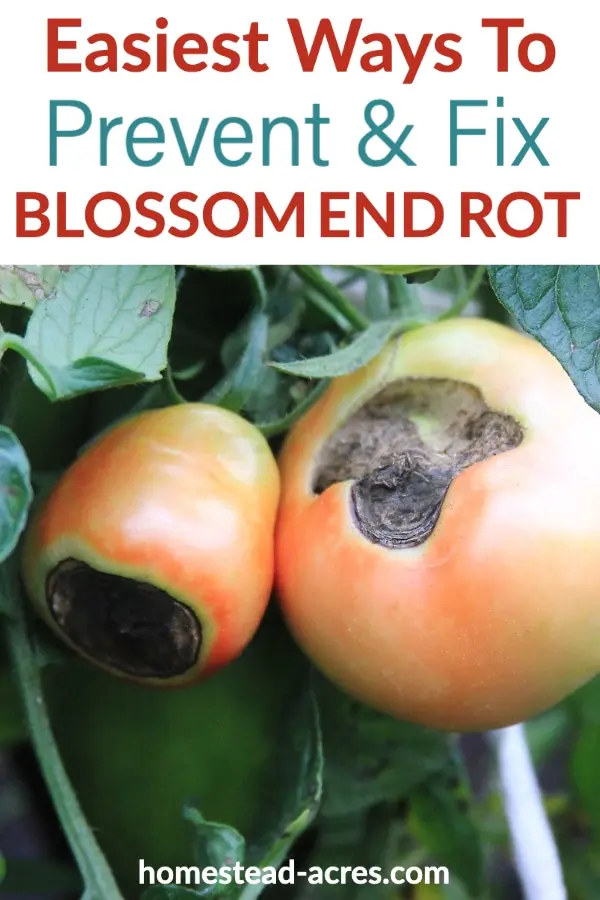
What Is Blossom End Rot?

When you start seeing black spots starting to form on the end of your tomatoes, your first thought might be that you have a disease problem. But blossom end rot is a physiological problem, not a disease.
It’s caused by a calcium imbalance happening inside of your tomato plant but it’s easy to prevent, control, and cure with the right care.
You can recognize this problem easily as it starts to form on tomatoes either green or ripe.
At first, it looks like a soft, watery spot on the end of the tomato. Eventually, it turns into a brown, scab-like patch with a leathery texture.
What Causes Blossom End Rot In Tomatoes?
1. Watering Fluctuations
The main cause of blossom end rot is improper watering it can be from changes in natural rainfall or irrigation making the soil too wet or to dry.
This causes the plant to not be able to absorb enough calcium for good fruit development.
However, it’s also possible to have blossom end rot problems from cold soil, high salt levels, root damage, excess nitrogen, or the wrong soil pH.
How To Prevent Blossom End Rot
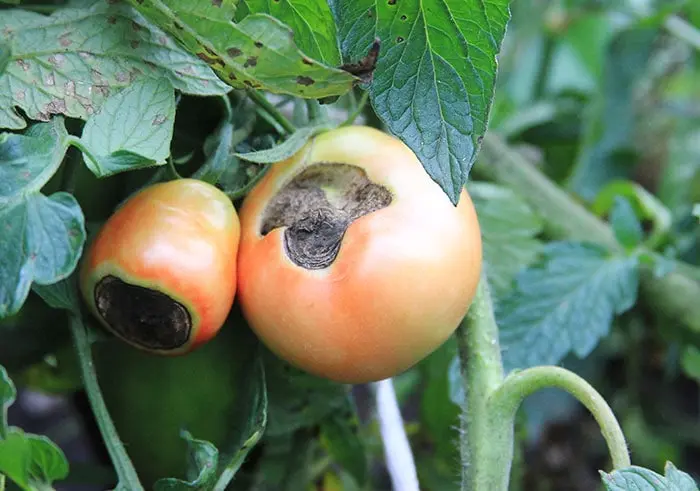
1. Water Consistently
It’s very important to water your tomato plants regularly to maintain a consistent level of moisture in the soil over your growing season.
When the hot summer weather arrives, water your tomatoes 1 to 2 times a week as needed. Make sure to water them deeply so the soil is moist down to about 6 inches (15.24 cm).
Deeper watering encourages the roots to grow deep into the ground where the moisture level is more consistent.
Take care not to overwater though. Plants should not be sitting in soggy soil as this can also stress them and stop the proper uptake of calcium or cause tomatoes to split open.
2. Use The Right Tomato Fertilizer
You might be tempted to use a high nitrogen fertilizer so your tomato plants look large and bushy. But that’s will only harm your tomato plants in the end.
Fertilizing with too much nitrogen can also cause your plants to not absorb the calcium they need. These are ammoniacal nitrogen fertilizers such as ammonium nitrate, ammonium sulfate and most all in one fertilizes like the 10-10-10 mix.
Instead, try using a fertilizer that is low in nitrogen and high in phosphorous. Calcium nitrate is a great choice for side dressing tomato plants.
3. Mulch Well
Mulching helps maintain an even moisture in the soil.
So mulching deeply around your plants with straw, wood chips, or your other favorite organic mulch will help to lengthen the amount of time needed between watering and protect the plants from quick changes in soil moisture.
4. Warm Soil
Come spring, you are really excited to get your tomato plants in the garden as soon as possible. But make sure to wait until the soil has warmed up first.
Plants can’t properly take nutrients from the soil when it’s colder than their normal growing needs.
5. Careful Weeding
Sometimes blossom end rot can happen when you are too aggressive with soil cultivation around your plants.
This can damage the roots and interfere with their ability to take up nutrients from the soil to properly feed the growing tomato plant.
Stick to surface weeding and use hand weeding or mulch to suppress weeds closer to the plants to avoid damage.
How Do I Fix Blossom End Rot On My Tomatoes?
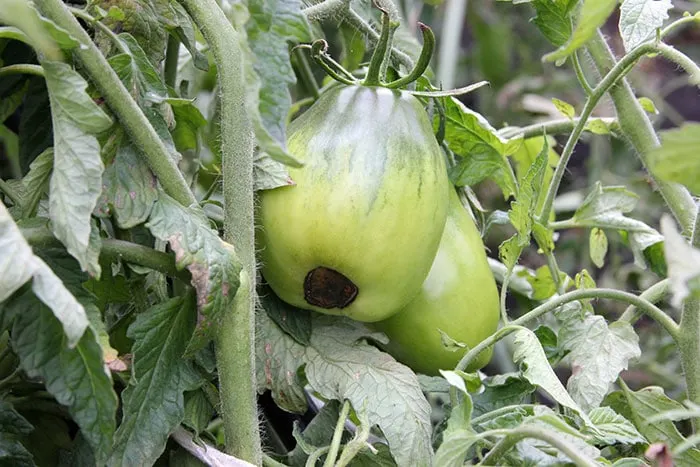
After finding this problem in your garden you are probably wondering, can you stop blossom end rot once it starts right?
Don’t worry if you already have tomatoes suffering from blossom end rot you can still save them.
Unfortunately, the fruit that already has the black scab on the bottom can’t be reversed.
You can either pick them off early and compost them or let them grow and just slice off the ugly end before using if the damage isn’t too bad.
But with a little care, you can turn the plants around.
First, make sure to use the preventative tips above to make sure you are watering correctly and consistently.
Then you can try giving your plants a calcium boost. Most of the time there is already enough calcium in your soil but giving a boost that can be easily absorbed by the plants can really help.
There are many ways you can do this including adding crushed eggshells to your soil. But it takes time for those to break down into something your plants can use.
Instead, try using a powdered bone meal fertilizer that can be dissolved in water. This is naturally high in calcium and easily absorbed by plants.
Another option is to use powdered milk. It can be mixed lightly into the soil around the plants or mixed up as a liquid and cut half and half with water, then used to water your plants.
Lime can also be used but only if a soil test shows you have a PH problem.
Of these 3 options, the bone meal fertilizer is my favourite because it’s easy to apply and doesn’t cause any odor problems in the garden as milk can occasionally.
What About Epsom Salts?
Epsom salts have long been said to prevent blossom end rot. But this long time cure could actually be causing the problem in your garden.
Epsom salts contain magnesium sulfate, not calcium. Adding Epsom salt to your soil could actually cause rot to form because the magnesium and calcium compete for absorption by the plant.
Remember that tomatoes are pretty easy to grow, that’s why they are such a popular garden vegetable. Just take care to water them properly from the beginning and if needed add a boost of calcium to your soil.
Connect With Homestead Acres!
Be sure to follow me on social media, so you never miss a post!
Facebook | Twitter | Pinterest | Twitter
Visit my Amazon store to find all my favorite gardening, homesteading tools, and gadgets plus all of my printed garden books and journals!

Kim Mills is a homeschooling mom of 6 and lives on an urban homestead in Ontario, Canada. Blogging at Homestead Acres she enjoys sharing tips to help you save money, grow and preserve your own food.


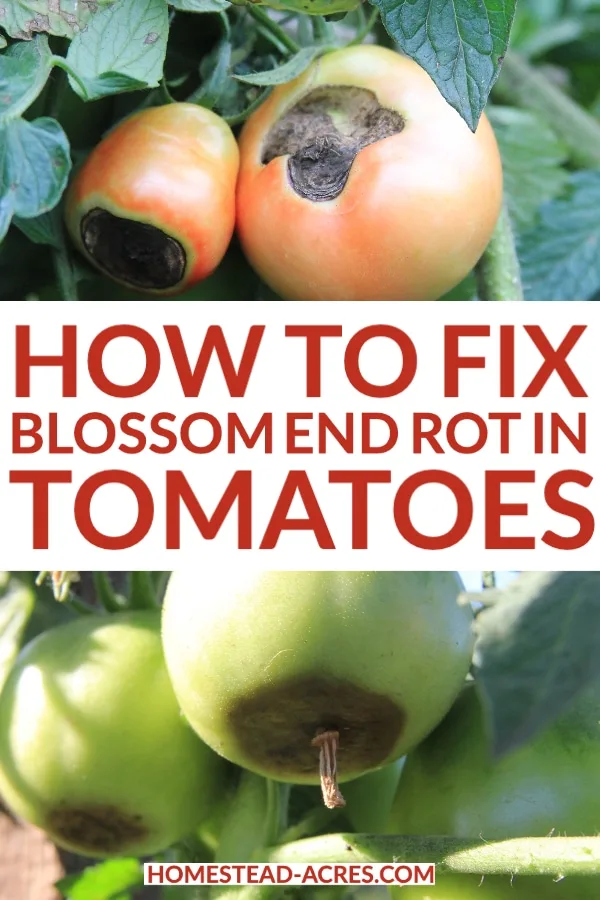
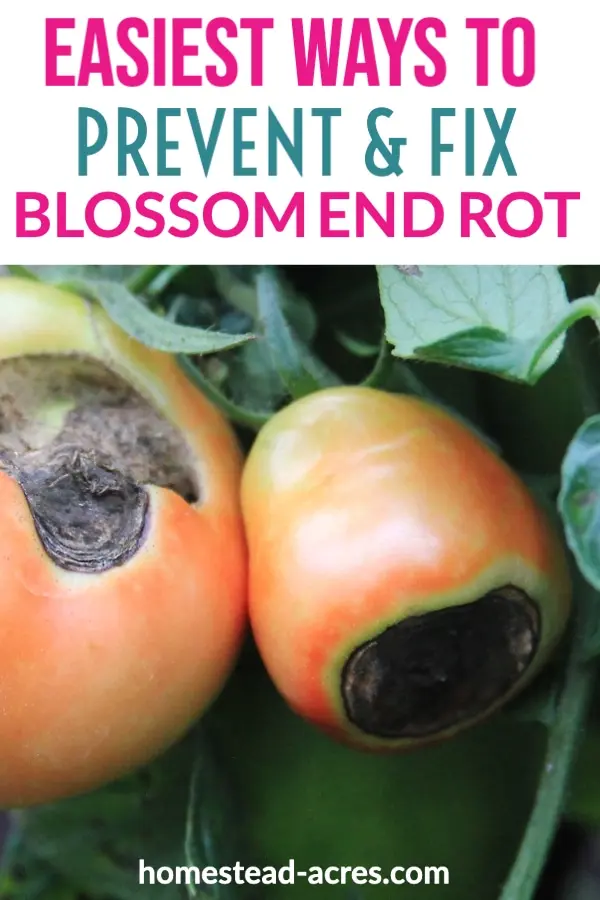
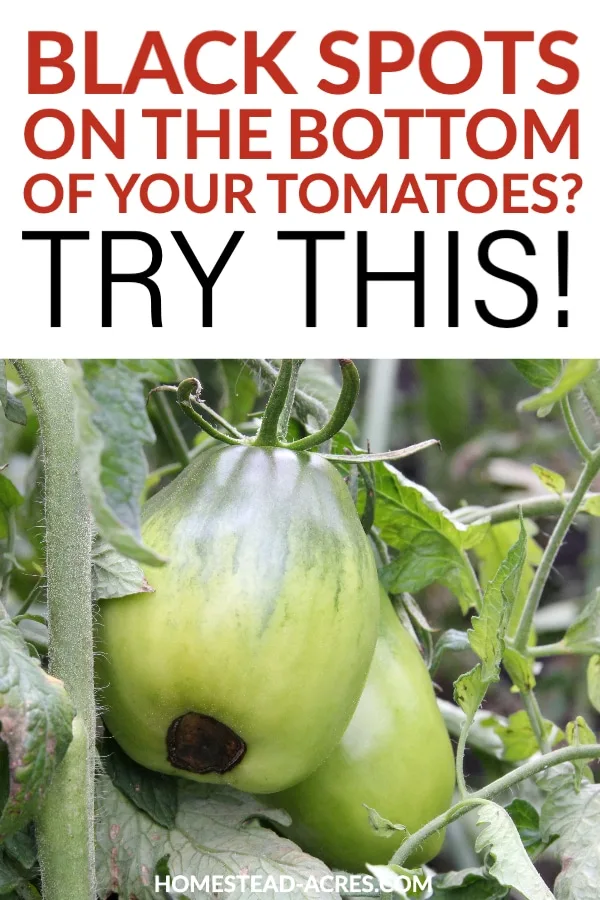
Bear
Wednesday 6th of March 2024
Why go through all that work? Many suggest using eggshells - but they break down too slowly to save the day. Go to the pharmacy and buy a bottle of Calcium pills. (I use Nature's Bounty 1200mg., readily available most anywhere.) About 1 pill per plant is plenty. Wrap them in a clean rag and smack with a hammer, then sprinkle around base of plant. It needn't be a powder, but finely mashed for quick absorption. Many pills have an enteric coating to keep them from absorbing TOO quickly, especially those labeled "slow acting". NOTE: Don't overdo it - there is such a thing as calcium poisoning. Not harmful to humans but a plant killer. Use one 1 pill (or less, for young plants), then water it in - plants will begin receiving calcium immediately. Do this at early blossoming and before tomatoes begin forming for best results. Bear
Mike
Thursday 20th of October 2022
I've been wrestling with this problem for years and have tried egg shells. I live in Mexico now and oddly lime is not readily available here, let alone bone meal... so your suggestion of powdered milk really hits the spot.
Thanks for that
Lisa
Saturday 2nd of July 2022
I grew my tomatoes in a big planter this year the leaves are curling up the tomatoes are getting leathery brown spots on bottom while there still green I put 10 10 10 on them table Spoon in each container I let them get morning sun but there in the shade in the evening it’s been very hot I watery them late evening but nothing seems to help I see no bugs under or on leaves what can I do please help.
Bear
Wednesday 6th of March 2024
@Lisa, Your error is watering in the evening - this causes fungus to form. Water in the morning instead, and only at the base. This gives gives the sun and wind the leaves a chance to dry out so fungi won't form. Bear
Nancy Cackler
Thursday 5th of May 2022
Great article and I will implement it in our "Pickle Patch". Our plot is 25ft x 100 ft. We are community gardening as our yard is too shady. We had to find some way to grow our own cucumbers for dill pickles and bread and butters. This is the first article I have read in your blog. Do you have articles on companion planting? We are planting sweet basil (for pesto) in between the tomatoes as they are good companions. Also, doing 3-sisters. I homeschooled and like the Charlotte Mason method. That was a long time ago when homeschooling was just taking off.
Jen
Sunday 16th of July 2023
@Nancy Cackler, just read your response, I planted basil with strawberries this year (pots) and have been harvesting my best basil and strawberries ever!! These two adore their environment together! Guests have even been commenting on what’s planted lol … and very pretty together as well 😊
John
Sunday 1st of August 2021
Since when did calcium nitrate become a low nitrogen product.